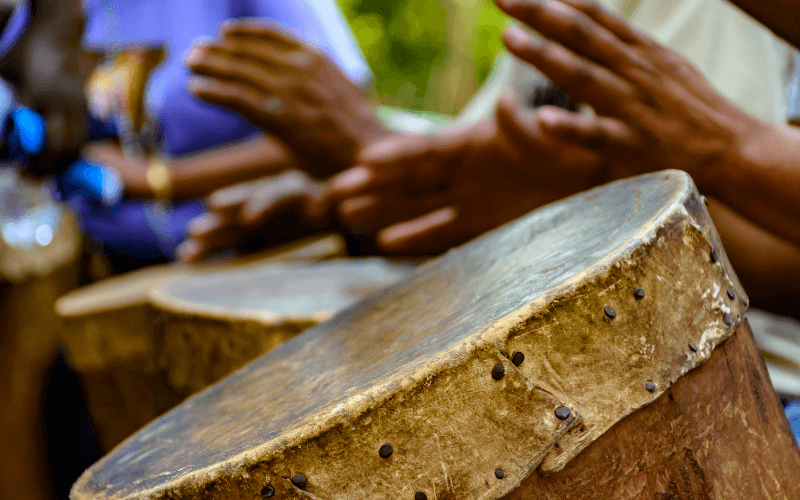Afro-Brazilian Religion
“In Brazil, Slavery created contact between the religions of various African nations that ended up assimilating and exchanging similar elements from their cultures. This way, the rites juxtaposed and fused in a common amalgam from where the African-Brazilian religions came to be.
Candomblé is one of the most known AfricanBrazilian religions in the whole country, which has a pantheon composed of the orixás, inquices and voduns, deities of the Yoruba, Bantu, and Jeje people, respectively. African-Brazilian religions receive different names depending on the place and the model of their rites.
- In the Northeast, there is Tambor-de-Mina in Maranhão
- Xangô in Pernambuco
- Candomblé – Bahia, Rio de Janeiro and São Paulo
In Rio de Janeiro and São Paulo, Umbanda and Candomblé prevailed and the South has:
- Batuque in the Rio Grande do Sul.
This scenario makes evident the African permanence and transformations in the African-Brazilian religions. From a historical perspective, all these forms of religiousness were seen by the European and Christian colonizers as dangerous expressions of adoration and sin, to be rooted out in order to grant the slaves’ souls salvation. This is the view that associates the African-Brazilian religious expressions, such as the Candomblé and the Umbanda, to demoniacal rites and witchcraft, remains to this day.”
In: AFRO BRAZIL MUSEUM. Tour of the collection. São Paulo: 2007, p. 18-20.

Afro-Brazilian religions are those that originated in the culture of several African peoples brought to Brazil as enslaved between the 16th and 19th centuries.
Afro-Brazilian religions Have an important role in preserving the cultural traditions of different black ethnic groups (Afro-Brazilians), there are also, currently, many more whites and other ethnic groups that adhere to the African-Brazilian religions these days, especially Candomblé and Umbanda.
- Candomblé Ritual
Candomblé is not a single religious cult, but rather a series of closely related cults, like other religions that have different denominations, with some differences in theological precepts and rituals. The various temples and aspects of Candomblé are usually grouped into “nations”, the most known and disseminated in the media being the so-called Queto nation. Along with other nations such as Efã, Ijexa, Nagô, and Mina-Nagô, it belongs to the trunk known as Yoruba, with African origins located in parts of Nigeria and Benin. There are also Candomblés from Angolan and Jeje nations, among others lesser-known. The name candomblé is historically associated with the cults of Bahia, but similar religions receive other regional names, such as xangô in Pernambuco, tambourine in Maranhão, and batuque in the Rio Grande do Sul. The term candomblé, however, has spread to other regions of the country. Brazil and other countries as the religion gain more adherents. Even because of these variations, some people simply prefer to name this set of cults with the name of the religion of the orixás, leaving aside the differences between them.
- Umbanda Ritual
Umbanda is a Brazilian religion resulting from the mixture of elements of African, indigenous, oriental, and European religions (Catholicism and Kardecist spiritism). Due to its mestizo and syncretic aspect, Umbanda is considered a genuinely national religion.
The word Umbanda comes from the Bantu language and has two meanings: “place of worship” and “priest”. According to Caboclo das Sete Encruzilhadas, a messenger responsible for defining the bases of this religion, “Umbanda is the manifestation of the spirit for charity.”
Umbanda is a monotheistic religion – that is, it recognizes the existence of a single god, below which there are the orixás (also worshiped in Candomblé) and the protective entities or guides (ancestral spirits). Thus, Umbanda can be understood as the worship that incarnated spirits render to God through the orixás and discarnate spirits.
Umbandistas believe that the orixás and ancestral entities inhabit another plane of existence. The orixás are ancient Yoruba deities whose worship was brought to Brazil by enslaved blacks.
The African-Brazilian Regions Orishás
The orixás are deities of Yoruba African mythology who became popular in Brazil with the African-based religions Umbanda and Candomblé. Yoruba is a region of Africa made up of diverse ethnic groups with similar languages and cultures.
Many of the blacks brought to Brazil as enslaved were from the region of Yoruba. There are hundreds of orishás in Yoruba mythology, some of them have become more famous in Brazil, such as Exú, “Olodumare”, Oxalá, Ogum, Oxóssi, Xangô, Iemanjá, Oxum, and Iansã.
Olodumaré – Also known as Olorum, is the supreme and inaccessible God. He created the world and the orishas to govern it and serve as intermediaries between him and humans.
Some of the most popular orixás in Brazil are:
- Exu – Messenger orishás, owner of the crossroads and guardian of the entrances. His symbols are the trident or the ogó (wooden stick). In syncretism, it’s Santo Antônio.
- Oxalá – The most important orishá is the creator of humanity. His symbol is white and his quality is wisdom. In syncretism, he is Jesus Christ.
- Ogum – The warrior orixá, associated with metallurgy, fighting, and work. His symbol is the sword. In syncretism, he is Sant Jorge.
- Oxossi – The hunting orixá, identified with forests, animals, and plants. His symbol is the bow and arrow. In syncretism, he is Sant Sebastian.
- Shango – The orisha of justice and thunder. The symbol of Xangô is the ax and, in syncretism, it is identified with Saint Jerome.
- Iemanjá – A female orixá of salt waters, Iemanjá is the Queen of the Sea. Her color is light blue and white. She is identified with Our Lady.
- Oxum – A female orixá of freshwaters, associated with motherhood, fertility, beauty, and love. her symbol is gold. She is identified with Our Lady of Conception.
- Iansã – A female orixá of lightning, storms, thunder, and gales. Her symbol is lightning. In syncretism, she is Santa Barbara.

Hey site owner, I like blogengine.net but why did you chose it? I mean its so neat with the random avatars and draws people in, but what speficially made you want to use it?